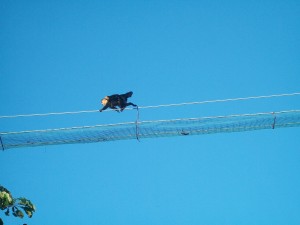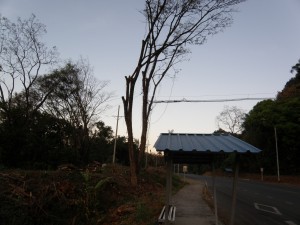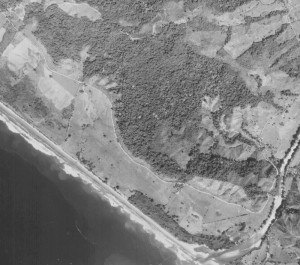A Bridge to Nowhere
Those of us who live within the bounds of the Path of the Tapir Biological Corridor are among a privileged few. With most of the world suffering the impacts of over development we live in one of the few places in the world where biodiversity is increasing and has been doing so since the mid 1980s. This is due to a number of factors including the work of many people who live here and understand the importance of restoring wildlife habitat. The work of the Asociación Amigos de la Naturaleza del Pacífico Central y Sur (ASANA) on the biological corridor project has been the driving force that has influenced the change.
The Path of the Tapir Biological Corridor is bounded by the Savegre River to the north, the Tinamastes Ridge to the east, the Grande de Térraba River to the South, and the Pacific Ocean to the west. As late as the 1920s the area which comprises what is now the corridor was completely wild land covered by primary rainforest and inhabited by a multitude of fauna. The first settlers to move into the area cleared the land with axes and machetes. Then they used it to grow crops and raise cattle. By the 1950s people were using chain saws and bulldozers to fell the trees and clear the land. By the early 1970s when I came to Hacienda Barú most of the usable land had already been cleared, primarily for cattle pasture. Beef export for the fast food industry in North America was a big business in Costa Rica, and raising cattle was profitable. In this region Hacienda Barú was one of the few places that hadn’t been entirely deforested. Of its 330 hectares (815 acres,) almost half had been cleared for cattle ranching and rice farming. There was a mangrove estuary and two small forest fragments in the lowlands and about 170 hectares(420 acres) of primary rainforest in the highlands. The rest was mostly devoid of trees.
 In the past when it had been necessary to build a fence, the first step was to cut down some trees. These were then split into posts using metallic wedges of different sizes which were driven into the trunk with a sledge. The problem was that all of the good trees, the ones that were resistant to rot, had already been cut down, and posts made from those that remained would rot in less than five years. For that reason I decided to use living posts. Instead of cutting down trees, we would be planting them, and when they were well rooted and thick enough, we would nail the wire to them. In the tropics certain species of trees can be grown from a cutting. In other words you can cut a branch off of the tree, stand it up in the shade until roots sprout from the bottom end, dig a shallow hole, stick it in the ground, and it will grow into a tree. In the late 1970s we started using this type of posts every time we had to build a fence. The types of trees that grow from cuttings are almost always fast growing species. In the tropics that means that they can easily reach three to four meters in height in a couple of years.
In the past when it had been necessary to build a fence, the first step was to cut down some trees. These were then split into posts using metallic wedges of different sizes which were driven into the trunk with a sledge. The problem was that all of the good trees, the ones that were resistant to rot, had already been cut down, and posts made from those that remained would rot in less than five years. For that reason I decided to use living posts. Instead of cutting down trees, we would be planting them, and when they were well rooted and thick enough, we would nail the wire to them. In the tropics certain species of trees can be grown from a cutting. In other words you can cut a branch off of the tree, stand it up in the shade until roots sprout from the bottom end, dig a shallow hole, stick it in the ground, and it will grow into a tree. In the late 1970s we started using this type of posts every time we had to build a fence. The types of trees that grow from cuttings are almost always fast growing species. In the tropics that means that they can easily reach three to four meters in height in a couple of years.
I was amazed to see that with only a single line of trees about twice as tall as a tall person, the monkeys started using them to move between forest fragments. The first time I saw white-faced capuchin monkeys moving down a line of trees was a little over two years after the trees had been planted. At that time there was a troop of monkeys in the mangrove estuary, located in the lowlands near the mouth of the Barú River, and several troops in the highland rainforest. Occasionally monkeys would move from one to the other. Prior to the living fences this meant crossing 400 meters of open pasture. I once saw a big dog go after a monkey that was walking across this gap. Sure that the dog would kill the monkey, I cringed in anticipation of the slaughter that I expected to take place. To my surprise the monkey jumped on the dog’s back, dug its claws into the dog’s flanks, gouged the dog’s eyes with its fingers and bit the dog’s ears. The terrified dog yelped, screamed, rolled, and ran in tight circles trying to rid itself of the monkey. When the monkey finally let the dog go, it ran for home with its tail between its legs. Though we didn’t realize it at the time, the living fences we were planting would eventually provide a means for the monkeys to move between forest fragments without risking encounters with dogs, coyotes and other predators.
Even though these living fence lines were only one tree wide, they were functioning as wildlife corridors in their simplest form. When people ask me how wide a biological corridor has to be, I always say that it has to be at least one tree wide, but anything wider than that is better. One line of trees is better than 400 meters of open pasture, as I’m sure the monkey that encountered the dog will agree, or maybe in this case, the dog that encountered the monkey. A corridor 100 meters wide is better than that, and, of course, one a kilometer or five kilometers wide is better yet. There were two areas in the lowlands of Hacienda Barú where poor soil conditions prevented the establishment of good pasture grasses. Having seen how the monkeys would use a single line of trees as a passage way, I decided to let these marginal strips of land regenerate into secondary forest. There were two of them, and each was about 100 meters wide. One connected the mangrove to the primary forest near the our house, which we called “la casona,” where today there is the ASANA office and a biological research center. The other corridor was located near the present day Hacienda Barú Lodge.
As the secondary forest of these two corridors matured more and more animals started using them. At that time the road was narrow, rough, and there wasn’t much traffic. Nevertheless, the arboreal animals preferred not to come to the ground to cross it. The lodge corridor had a place where two large tree branches, one from each side of the road, arched out above the road and overlapped, thus providing a natural bridge where the animals could cross. The casona corridor didn’t have any overlapping branches, but we had suspended a black plastic water pipe from one treetop to another, across the gravel road, in order to carry water to our house, la casona. One night, while photographing bats, a biologist noticed something walking across the top of the water pipe. Unable to identify the moving creature in the darkness, he snapped a photograph. Much to our surprise, the developed print revealed the animal to be an olingo (Bassaricyon gabbi), the first one ever identified on the Hacienda Barú reserve. After this incident, we began to closely watch the suspended pipe and soon discovered that many other animals, such as monkeys, sloths, anteaters, opossums and coatis, were using the water pipe as a means to safely cross the road. I’m sure that all of these animals would have preferred to cross the road on tree branches, but since that option didn’t exist, they quickly adapted to the artificial structure.
Bridges for wildlife have been built in several places. At one time there were some animal bridges across the highway to the south of Dominical in the Playa Hermosa area. These were done by ICE, the electrical institute. They were made of netting and were very flexible. I don’t know how effective they were, as I don’t know of anyone who has ever seen an animal cross the road on one of them. In Manuel Antonio a local conservation group has stretched thick ropes across the roads so the squirrel monkeys can cross. These have been very effective. However the roads at Manuel Antonio are narrow and the bridges are fairly short, no longer than 20 meters.
When the Ministry of Transport (MOPT) started doing the studies for the new highway, we at Hacienda Barú began negotiating for measures that would maintain connectivity and minimize the amount of animals killed on the road. Due in part to our insistence, several conditions were written into the environmental impact statement (EIS) of the new highway. The EIS stated that bridges and tunnels to facilitate animal crossings would be build on the three kilometers where the highway traversed Hacienda Barú National Wildlife Refuge. In the end there were a total of 21 tunnels and four bridges. Two of the bridges were built at the lodge corridor and the other two at the casona corridor. The tunnels were placed in locations where animals had always crossed the road.
The tunnels were all square. Experiences in other parts of the world show that animals will use a square or rectangular tunnel, but shy away from a round one. At Hacienda Barú a few of the animals started using the tunnels right away, and with time more and more animals learned to use them. This was evident from the tracks at the approaches to the tunnels. It was also evident that as the usage of the tunnels increased, the amount road kill diminished.
 The animal bridge design consists of two cables with space bars to keep them separated. Then the whole bridge is wrapped in green netting, the kind used in plant nurseries. The bridges are about 40 centimeters wide, a natural color and semi-rigid like a tree branch. Primate specialist Florence Vallet suggested putting another cable about 30 centimeters above the bridge so that animals with prehensile tails could grab onto it. The highway department agreed to this modification, and it was incorporated into the bridge design. The main problem with the bridges was their length, the longest being 63 meters and the shortest 26 meters. We knew that monkeys, opossums, raccoons, kinkajous, olingos and anteaters would use a bridge, but we weren’t sure they would use one that long. A year went by and nobody had reported seeing an animal on a bridge. The monkeys were still crossing the road on foot, and at least two have been hit by cars and killed. A year and seven months after the completion of bridges an employee of Hacienda Barú watched and photographed a troop of monkeys crossing the highway on one of the bridges at the casona corridor, the shortest one. Curiously they used the single cable above the bridge that had been suggested by Florence. Later they were seen on the bridge itself. Soon thereafter they started using the other bridge on the same corridor. This one was 43 meters long. Since that time many sightings have been reported and many photographs have been taken. Tourists became very emotional at seeing them. One lady commented how nice it was to be in a country where the Highway Department would care enough to provide animal crossings. “This is a wonderful example for the rest of the world,” she said.
The animal bridge design consists of two cables with space bars to keep them separated. Then the whole bridge is wrapped in green netting, the kind used in plant nurseries. The bridges are about 40 centimeters wide, a natural color and semi-rigid like a tree branch. Primate specialist Florence Vallet suggested putting another cable about 30 centimeters above the bridge so that animals with prehensile tails could grab onto it. The highway department agreed to this modification, and it was incorporated into the bridge design. The main problem with the bridges was their length, the longest being 63 meters and the shortest 26 meters. We knew that monkeys, opossums, raccoons, kinkajous, olingos and anteaters would use a bridge, but we weren’t sure they would use one that long. A year went by and nobody had reported seeing an animal on a bridge. The monkeys were still crossing the road on foot, and at least two have been hit by cars and killed. A year and seven months after the completion of bridges an employee of Hacienda Barú watched and photographed a troop of monkeys crossing the highway on one of the bridges at the casona corridor, the shortest one. Curiously they used the single cable above the bridge that had been suggested by Florence. Later they were seen on the bridge itself. Soon thereafter they started using the other bridge on the same corridor. This one was 43 meters long. Since that time many sightings have been reported and many photographs have been taken. Tourists became very emotional at seeing them. One lady commented how nice it was to be in a country where the Highway Department would care enough to provide animal crossings. “This is a wonderful example for the rest of the world,” she said.
During a two month period the monkeys used both of the bridges at the casona corridor almost daily. We think there were two different troops of monkeys using the bridges, but aren’t 100% sure. We do know that there are seven troops of monkeys on the lowlands of Hacienda Barú that potentially have access to the bridges. We wondered how long it would take the other troops to learn. Occasionally a monkey will move from one troop to another. This might be, for example, a young male that is expelled from his troop by a dominant male, and is later accepted into another troop. If a monkey from a troop that knew about crossing the bridges ended up in another troop, would it teach the monkeys of his new troop to cross the bridges? Only time would tell.
Unfortunately, this was not to be. The Costa Rican Electrical Institute (ICE) decided to move the electrical lines and run them along the edge of the new highway. With total disregard for the environmental impact statement of the highway and total disregard for the biological corridor and everything that had been accomplished, they destroyed the monkey’s passage way. The photo tells the story. The monkeys now arrive at the bridges, look across, and turn around and go back into the forest, because now the two bridges go to nowhere.



Shame on ICE!!!
Is anything being done to restore these bridges.
I will be back in CR this fall.
What can I do to help?
Michael
Pura Vida